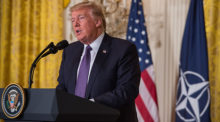Daviel Lazure-Vieira
During the first week of class, Sam Tanenhaus began his University of Toronto course by surveying the room. “How many of you are either from the United States, or know people living in the United States?” he asked. Several hands went up. “Now, how many of you know people who voted for Donald Trump?” About three dozen hands again. “I said, ‘Congratulations, there are more people in this room, right now, who have a connection to Trump, than the entire newsroom of the New York Times. Because if I asked them the same question, I’d be lucky to see five hands. You already got an advantage over a lot of American media.’
Tanenhaus surely knows. He is former editor-in-chief of The New York Times Sunday Book Review and Week in Review, and is now a contributing columnist for Bloomberg View, as well as U.S. writer-at-large for the British monthly, Prospect. His resume includes bylines at The New Yorker, Vanity Fair, and The Atlantic. Tanenhaus is currently working on a biography of William F. Buckley Jr., perhaps the “most influential and successful intellectual architect” of the American conservative movement.
This fall, Tanenaus is a visiting professor at St. Michael’s College, an invitation co-sponsored by the Dean of the Faculty of Arts and Science and the Munk School of Global Affairs and Public Policy. During his time at U of T, he is teaching two undergraduate courses: a fourth-year seminar on how governments, political parties, news agencies and other organizations use the media to influence public discourse, and a third-year course offered jointly by St. Mike’s and the Munk School’s Centre for the Study of the United States called “Trump and the Media”.
With such a title, it’s obvious that the course will partly be shaped by current news. But Tanenhaus doesn’t simply wish to defend the fourth estate repeatedly criticized by the sitting U.S. president. He will also look carefully at the mistakes they have made, and examine what this fraught relationship says about the fractured, divided nature of American society. It’s the perfect lens to analyze the growing gap – economic, cultural, social – between big cities like New York and Los Angeles and the American heartland. Or the disparity between different generations, from those who remember Watergate and the Nixon administration’s war on the media, to those raised in the era of reality television—best embodied, perhaps, by Trump’s very own show The Apprentice.
It’s likely one of the reasons why students are particularly interested in the course—because it’s also about them. “When you’re my age, you really do need to hear from young people,” Tanenhaus explains. “It’s not about dispensing one’s own ostensible wisdom, it’s really quite the opposite. If you want to be an active and useful writer, you have to know what’s going on, and you get it more from the younger generation than from almost anyone else.”
The course’s first assignment, “Tweet like Trump,” asks students to follow an immediate, more “aggressive” line of argument designed for the age of social media. Another will ask them to persuade someone who doesn’t share their opinion. “It’s important to hear other people talk. Especially now, when you can enter echo chambers and never leave. I want students to understand that you can actually take whatever belief you now subscribe to, and turn it upside down – and see that there’s some sense to it, some reason for it, too.” For Tanenhaus, it’s a kind of empathy that’s sorely missing today – in journalism and elsewhere.
September 21, 2018
